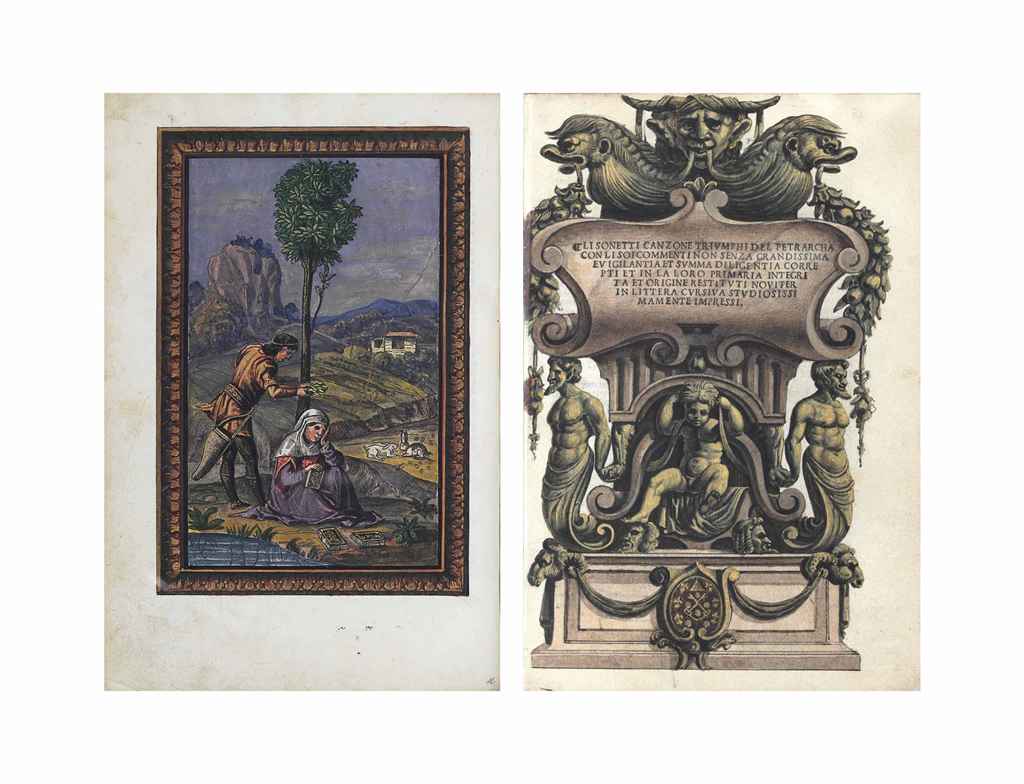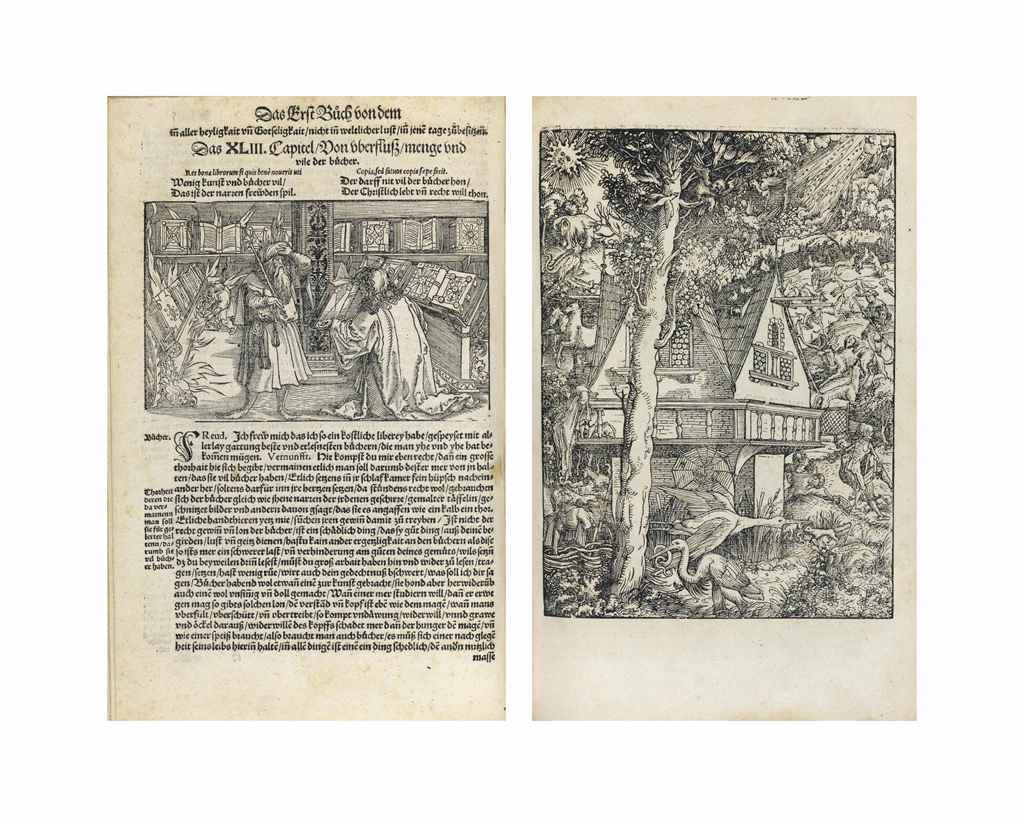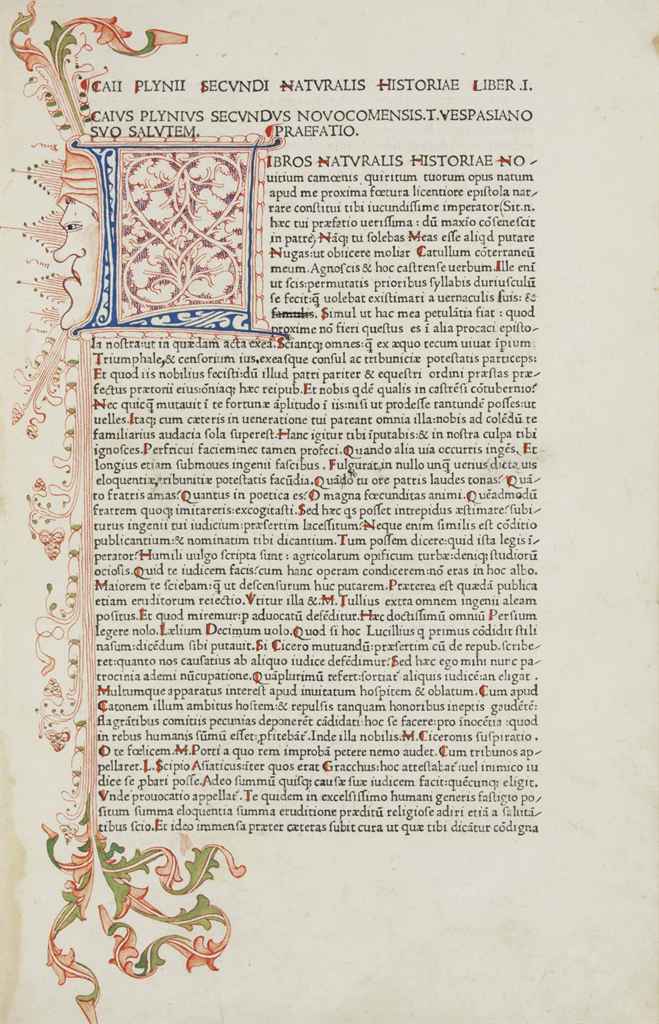HROSWITHA (ca 935-ca 1002). Opera . Edited by Conrad Celtes (1459-1508). Nuremberg: Printer for the Sodalitas Celtica, 1501.
HROSWITHA (ca 935-ca 1002). Opera . Edited by Conrad Celtes (1459-1508). Nuremberg: Printer for the Sodalitas Celtica, 1501. Super-chancery 2 o (302 x 212 mm). Collation: a 1 0 b-k 8 . 82 leaves. Roman type, woodblock containing two lines of Greek, woodcut device "AP" at end, 8 full-page woodcuts from 7 blocks, including 2 woodcuts by Albrecht Dürer initials in red. Contemporary South German blind-ruled pigskin over wooden boards, front cover with saltire formed with double fillets, contemporary manuscript vellum label on front cover, later white leather monastic spine from St. Peter's, Benedictine monastery at Salzburg, brass clasps and catches (metal cornerpieces removed). Provenance : Salzburg, Benedictines (binding, inkstamp on first and third works in the volume, see below) -- Acquired from Lathrop C. Harper, 1967. A VERY FINE COPY IN A CONTEMPORARY MONASTIC BINDING FIRST EDITION of an important literary publication of the German Renaissance. With the discovery of an 11th-century manuscript of the works of Hroswitha by Conrad Celtes at the Benedictine monastery at St. Emmeram in 1493, Germany was able to reclaim one of its great authors of the Middle Ages. Celtes circulated the manuscript among his fellow humanists, and it was published under the auspices of his literary society at Nuremberg, the Sodalitas Celtica, with two-line laudatory verse on Hroswitha by each member printed at the beginning. In true humanist style, Wilibald Pirckheimer, in whose house the society met, composed his verse in Greek. The manuscript, with notes by Celtes and others, survives at the Bayerische Staatsbibliothek. Included here are her six prose plays ("Comediae"), written in loose imitation of Terence, eight sacred histories in verse, and a panegyric on her patron, Otto I. Among the fine woodcuts are two by Albrecht Dürer The attribution, always strong, was confirmed on the discovery in 1898 of the original sketch of the second woodcut, now at Bayonne. The remaining woodcuts have been attributed to Wolf Traut Hans Suess von Kulmbach and various anonymous masters; current scholarship assigns them to the Master of the Comedies-woodcuts. The colophon in the present copy conforms to the issue described by Fairfax Murray as the corrected issue, after mistakes were corrected. Matthias Mende states that there are 5 states of the edition without identifying their points. Fairfax Murray German 210; Meder 242, 243; R. Schoch, M. Mende, and A. Scherbaum, Dürer: Das Druckgraphische Werk, Buchillustration , 268. Fact and Fantasy 10. [ Bound after :] OROSIUS, Paulus (fl. 414-417). Historiae adversus paganos . Edited by Aeneas Vulpus. Venice: Bernardinus Venetus, de Vitalibus, 12 October 1500. 2 o . Collation: a-m 6 n 8 . 79 (of 80, lacking first blank) leaves. Type 111R. Printer's device (device A) on final leaf, a few ornamental woodcut initials, initials in red. Provenance : Salzburg, Benedictines (inkstamp on first leaf). Apparently reprinted from Scotus' 1483 edition. HC *12104; BMC V, 549; Goff O-101. [ Bound after :] RABANUS MAURUS (776-856). De laudibus Sancte Crucis . Edited by J. Wimpheling. Pforzheim: Thomas Anshelm March 1503. 2 o . Collation: Aa 6 Bb 4 , a-k 6 , A B 6 , C 4 . 85 leaves, including final blank. Printed in red and black. Roman type. Woodcut of two monks kneeling before the Pope, woodcut of the author presenting his book to Pope Gregory IV, 30 full-page xylographic and typographic figurative verses, the figures representing Emperor Louis I, Christ, cherubs, crosses, symbols of the Evangelists, etc., woodcut lombard or Maiblumen initials in red. FIRST EDITION. The remarkable woodcuts are among the earliest examples of figurative verse. They are produced by a combination of xylography and typography. The more complicated of the images are entirely xylographic, while others have the figure (and letters within or adjacent to it) cut into wood with the remaining letters set in type, and the most simple ones are purely
HROSWITHA (ca 935-ca 1002). Opera . Edited by Conrad Celtes (1459-1508). Nuremberg: Printer for the Sodalitas Celtica, 1501.
HROSWITHA (ca 935-ca 1002). Opera . Edited by Conrad Celtes (1459-1508). Nuremberg: Printer for the Sodalitas Celtica, 1501. Super-chancery 2 o (302 x 212 mm). Collation: a 1 0 b-k 8 . 82 leaves. Roman type, woodblock containing two lines of Greek, woodcut device "AP" at end, 8 full-page woodcuts from 7 blocks, including 2 woodcuts by Albrecht Dürer initials in red. Contemporary South German blind-ruled pigskin over wooden boards, front cover with saltire formed with double fillets, contemporary manuscript vellum label on front cover, later white leather monastic spine from St. Peter's, Benedictine monastery at Salzburg, brass clasps and catches (metal cornerpieces removed). Provenance : Salzburg, Benedictines (binding, inkstamp on first and third works in the volume, see below) -- Acquired from Lathrop C. Harper, 1967. A VERY FINE COPY IN A CONTEMPORARY MONASTIC BINDING FIRST EDITION of an important literary publication of the German Renaissance. With the discovery of an 11th-century manuscript of the works of Hroswitha by Conrad Celtes at the Benedictine monastery at St. Emmeram in 1493, Germany was able to reclaim one of its great authors of the Middle Ages. Celtes circulated the manuscript among his fellow humanists, and it was published under the auspices of his literary society at Nuremberg, the Sodalitas Celtica, with two-line laudatory verse on Hroswitha by each member printed at the beginning. In true humanist style, Wilibald Pirckheimer, in whose house the society met, composed his verse in Greek. The manuscript, with notes by Celtes and others, survives at the Bayerische Staatsbibliothek. Included here are her six prose plays ("Comediae"), written in loose imitation of Terence, eight sacred histories in verse, and a panegyric on her patron, Otto I. Among the fine woodcuts are two by Albrecht Dürer The attribution, always strong, was confirmed on the discovery in 1898 of the original sketch of the second woodcut, now at Bayonne. The remaining woodcuts have been attributed to Wolf Traut Hans Suess von Kulmbach and various anonymous masters; current scholarship assigns them to the Master of the Comedies-woodcuts. The colophon in the present copy conforms to the issue described by Fairfax Murray as the corrected issue, after mistakes were corrected. Matthias Mende states that there are 5 states of the edition without identifying their points. Fairfax Murray German 210; Meder 242, 243; R. Schoch, M. Mende, and A. Scherbaum, Dürer: Das Druckgraphische Werk, Buchillustration , 268. Fact and Fantasy 10. [ Bound after :] OROSIUS, Paulus (fl. 414-417). Historiae adversus paganos . Edited by Aeneas Vulpus. Venice: Bernardinus Venetus, de Vitalibus, 12 October 1500. 2 o . Collation: a-m 6 n 8 . 79 (of 80, lacking first blank) leaves. Type 111R. Printer's device (device A) on final leaf, a few ornamental woodcut initials, initials in red. Provenance : Salzburg, Benedictines (inkstamp on first leaf). Apparently reprinted from Scotus' 1483 edition. HC *12104; BMC V, 549; Goff O-101. [ Bound after :] RABANUS MAURUS (776-856). De laudibus Sancte Crucis . Edited by J. Wimpheling. Pforzheim: Thomas Anshelm March 1503. 2 o . Collation: Aa 6 Bb 4 , a-k 6 , A B 6 , C 4 . 85 leaves, including final blank. Printed in red and black. Roman type. Woodcut of two monks kneeling before the Pope, woodcut of the author presenting his book to Pope Gregory IV, 30 full-page xylographic and typographic figurative verses, the figures representing Emperor Louis I, Christ, cherubs, crosses, symbols of the Evangelists, etc., woodcut lombard or Maiblumen initials in red. FIRST EDITION. The remarkable woodcuts are among the earliest examples of figurative verse. They are produced by a combination of xylography and typography. The more complicated of the images are entirely xylographic, while others have the figure (and letters within or adjacent to it) cut into wood with the remaining letters set in type, and the most simple ones are purely















Testen Sie LotSearch und seine Premium-Features 7 Tage - ohne Kosten!
Lassen Sie sich automatisch über neue Objekte in kommenden Auktionen benachrichtigen.
Suchauftrag anlegen